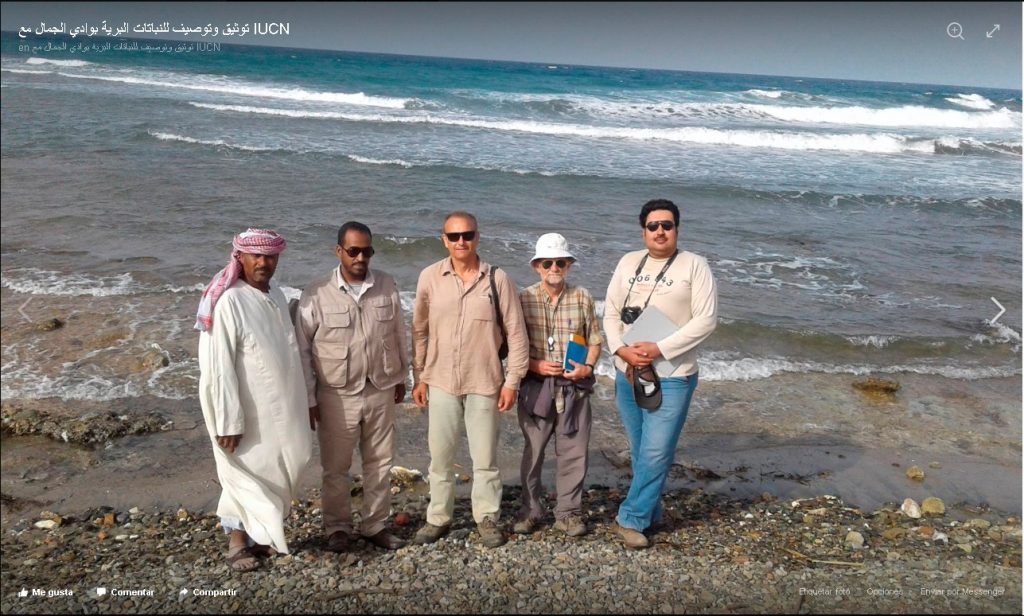This project has been possible thanks to the work of almost fifty participants and collaborators, distributed over various countries of North Africa and Southern Europe. In essence, we have thoroughly revised the content of the Guía de los Árboles y Arbustos del Norte de África (Charco, 2001) and numerous improvements have been made to the text, photographs and maps. Also, new species, genera and even families have been added, now that Egypt and a large part of Sudan are included. The following list names all the participating experts, sorted by their country of origin.
Coordination
Jesús Charco. Centro de Investigaciones Ambientales del Mediterráneo (CIAMED).
Algeria
- Salima Benhouhou. École Nationale Supérieure Agronomique. Algiers.
- Khellaf Rebbas. Mohamed Boudiaf University. M’sila.
- Nassima Yahi. University of Science and Technology Houari Boumediene. Algiers.
- Nabil Abdelkader Benghanem. École Nationale Supérieure Agronomique. Algiers.
- Zahira Souidi. Aïn Temouchent University.
Egypt
- Kamal Shaltout. Tanta University.
- Dalia Abd El-Azeem Ahmed. Tanta University
- Heba Bedair. Tanta University
- Tarek Galal. Helwan University, Cairo.
- Mohamed Zakaria Hatim. Tanta University.
France
- Errol Véla. University of Montpellier.
- Jean Paul Peltier. Teline.fr.
Germany
- Stefan Dressler. Senckenberg Research Institute, Frankfurt.
- Marco Schmidt. Palmengarten der Stadt Frankfurt.
Lybia
- Rafaa A. Essokne Shkwa. University of Tripoli.
- Mohamed Makhlouf. University of Tripoli.
- Rebeh Rahil. University of Tripoli.
Morocco
- Mohammed Fenanne. Institut Scientifique. Mohammed V University. Rabat.
- Mohammed Sghir Taleb. Institut Scientifique. Mohammed V University. Rabat.
- Zahora Attioui. www.atlas-sahara.org
- Claude Lemmel. www.atlas-sahara.org
Spain
- Juan A. Devesa. University of Córdoba.
- Helios Sainz. Autonomous University of Madrid.
- Benito Valdés. University of Sevilla.
- Joaquín Molero. University of Granada.
- Guillermo Benítez. University of Granada.
- Andrés V. Pérez Latorre. University of Málaga.
- Noelia Hidalgo. University of Málaga.
- Francisco Alcaraz. University of Murcia.
- Félix Carrillo. University of Alicante.
- Juan F. Mota. University of Almería.
- Francisco J. Pérez. University of Almería.
- Miguel Cueto. University of Almería.
- Esther Giménez. University of Almería.
- Agustín Lahora. University of Almería.
- Jaime Güemes. University of Valencia.
- Pedro Sánchez Gómez. University of Murcia.
- Juan F. Jiménez Martínez. University of Granada.
- Gloria Martínez Sagarra. University of Córdoba.
- Manuel de la Estrella. University of Córdoba.
- Esteban Salmerón-Sánchez. University of Almería.
- David Galicia Herbada. Autonomous University of Madrid.
- José Luis Villar. Universidad de Alicante.
- Fabián Martínez Hernández. University of Almería.
- Antonio J. Mendoza. University of Almería.
- Juan A. Garrido. University of Almería.
Switzerland
- Bertrand de Montmollin. Chair of the Mediterranean Plants Specialist Group (IUCN / SSC).
- Cyrile Chatelain. The Conservatory and Botanical Garden of the City of Geneva.
Tunisia
- Zeineb Ghrabi-Gammar. Institut National Agronomique de Tunisie, University of Carthage.
- Brahim Hasnaoui. Institut Sylvo-Pastoral de Tabarka, University of Jendouba.
- Amor Mokhtar Gammar. University of Manouba.
- Amina Daoud-Bouattour. Tunis-El Manar University.
Cartographic development
- Luis Alberto Longares. University of Zaragoza.
Photographs
The author is indicated under each photograph. Many photographers have contributed to this edition, always selflessly. We thank and appreciate their professionalism, philanthropy, and their love of nature. Some of them have made available to us all of their photographs and websites, and they deserve additional gratitude. We are deeply grateful to the following colleagues:
- Jean Paul Peltier. Biodiversité végétale du sud-ouest marocain. https://www.teline.fr
- José Quiles. Flora silvestre del Mediterráneo. http://www.florasilvestre.es
- Claude Lemmel & Zahora Attioui. Atlas Sahara. www.atlas-sahara.org
- Stefan Dressler, Marco Schmidt & Georg Zizka. African Plants – A Photo Guide. www.africanplants.senckenberg.de
- Khellaf Rebbas. https://spain.inaturalist.org/observations?place_id=any&user_id=khellaf-rebbas&verifiable=any
- Manfred Finckh. Photo Guide to Plants of Southern Morocco. ://plantsofsouthernmorocco.biota-africa.net/
Other important participants and collaborators
In the first place, it is worth highlighting the Mediterranean Cooperation Center of the International Union for Conservation of Nature (IUCN Med), for promoting the project, and the MAVA Foundation, for financial support. We would like to give special thanks to engineer Ahmed Salama, Director of the Nature Conservation Section of the Egyptian Environmental Affairs Agency (EEAA), Ministry of Environment of the Republic of Egypt. He facilitated our access to the exploration of several natural regions of Egypt. In the case of the Wadi Gimal Protectorate, this allowed us to be accompanied by environment agent Ayman El-Gharabawy and his teammates, Hassan and Hussain, the latter from the Ababda tribe. In the Saint Katherine Protectorate we were warmly welcomed by Mohamed Hemeda, who allowed us to explore the Protectorate, joined in the field by zoologist Amir Shaloufa, botanist Asmaa Ali and the Bedouin guides Seleem and Salim. In the rest of the country, everyone we met in the field was always kind and ready to help. We do not recall every name but we are very thankful to all of them.

In the African coast of the Red Sea, after a day of field work in the desert. Photograph by Ayman El-Gharabawy, with its original description on Facebook.
We also received help from specialists for the description of certain species. The Egyptian specialist Karim Abdelhai Omar, for example, helped us with the species Rosa arabica, that he knows so thoroughly. The help of Lola Almagro and Gonzalo Martínez Salcedo was very valuable in the transcription of texts. Silvia Jurado Güeto offered valuable help in map design. The most interesting common names for species from the Algerian Sahara were shared by Nacéra Boucheneb and Boudjema Bouzidi, nomad sedentarirez from Béni-Abbès (Béchar region).
We would also like to give special thanks to the translators, François Lassurguere, Patricia Malcolm and Mercedes Paz that, with their professionalism helped us to identify and correct small but numerous mistakes throughout the texts. And last but not least, we owe much gratitude to Catherine Levassor. This botany professor selflessly made a first translation of the text to French, in 2006, which remained unpublished due to financial reasons. Now that we have the means to publish it, we dedicate the French version of this new edition to her.

